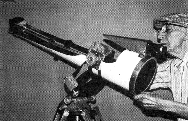Archived from: http://bhs.broo.k12.wv.us/homepage/alumni/dstevick/yolo.htm
The Yolo Telescope
Named after a county in California, the Yolo was invented by Arthur S.
Leonard of the University of California, Davis. It differs from a
Schiefspiegler in that both mirrors are concave. The Yolo enjoys three
advantages over the Schief with, (1) lower focal ratios possible, (2)
lower image tilts, and (3) a more compact form. Its one major
drawback probably accounts for so few Yolos built; it cannot correct
for astigmatism without help. Three methods to do this have been
successfully employed. Briefly, they are
(1) the use of a warping harness,
(2) polishing the correction into the secondary, and
(3) adding a spectacle lens inside focus.
Day unto day uttereth speech, and night unto night sheweth knowledge.
There is no speech nor language, where their voice is not heard.

|
From a design by José Sasian in "Telescope Making"
#37, Albert Priselac built this 6" f/10.2 Yolo.
| |
|
Erwin Herrig of the former East Germany,
without access to western literature, re-invented the Yolo.
|

|

|
Close-up view of Erwin Herrig's harness for warping the Yolo
secondary prior to final grinding and polishing. When the harness
is released, the finished mirror assumes a toroidal figure.
| |
|
The covering has been removed from the
telescope here to show internal details. An
English translation
of Erwin Herrig's method of figuring his toroidal
secondaries is available. (To come soon!)
|

|
More Yolo info here
Author: David Stevick
[Weird Telescopes Page]
Curator: Hartmut Frommert
[contact]
[Schiefspiegler Home]
[SEDS]



